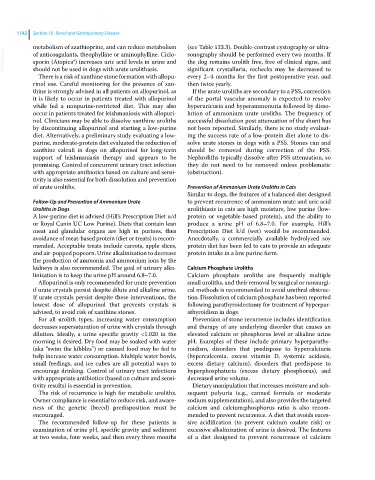Page 1204 - Clinical Small Animal Internal Medicine
P. 1204
1142 Section 10 Renal and Genitourinary Disease
metabolism of azathioprine, and can reduce metabolism (see Table 123.3). Double‐contrast cystography or ultra
VetBooks.ir of anticoagulants, theophylline or aminophylline. Ciclo sonography should be performed every two months. If
the dog remains urolith free, free of clinical signs, and
sporin (Atopica®) increases uric acid levels in urine and
should not be used in dogs with urate urolithasis.
every 2–4 months for the first postoperative year, and
There is a risk of xanthine stone formation with allopu significant crystalluria, rechecks may be decreased to
rinol use. Careful monitoring for the presence of xan then twice yearly.
thine is strongly advised in all patients on allopurinol, as If the urate uroliths are secondary to a PSS, correction
it is likely to occur in patients treated with allopurinol of the portal vascular anomaly is expected to resolve
while fed a nonpurine‐restricted diet. This may also hyperuricuria and hyperammonuria followed by disso
occur in patients treated for leishmaniosis with allopuri lution of ammonium urate uroliths. The frequency of
nol. Clinicians may be able to dissolve xanthine uroliths successful dissolution post attenuation of the shunt has
by discontinuing allopurinol and starting a low‐purine not been reported. Similarly, there is no study evaluat
diet. Alternatively, a preliminary study evaluating a low‐ ing the success rate of a low‐protein diet alone to dis
purine, moderate‐protein diet evaluated the reduction of solve urate stones in dogs with a PSS. Stones can and
xanthine calculi in dogs on allopurinol for long‐term should be removed during correction of the PSS.
support of leishmaniasis therapy and appears to be Nephroliths typically dissolve after PSS attenuation, so
promising. Control of concurrent urinary tract infection they do not need to be removed unless problematic
with appropriate antibiotics based on culture and sensi (obstruction).
tivity is also essential for both dissolution and prevention
of urate uroliths. Prevention of Ammonium Urate Uroliths in Cats
Similar to dogs, the features of a balanced diet designed
Follow‐Up and Prevention of Ammonium Urate to prevent recurrence of ammonium urate and uric acid
Uroliths in Dogs urolithiasis in cats are high moisture, low purine (low‐
A low‐purine diet is advised (Hill’s Prescription Diet u/d protein or vegetable‐based protein), and the ability to
or Royal Canin UC Low Purine). Diets that contain lean produce a urine pH of 6.8–7.0. For example, Hill’s
meat and glandular organs are high in purines, thus Prescription Diet k/d (wet) would be recommended.
avoidance of meat‐based protein (diet or treats) is recom Anecdotally, a commercially available hydrolyzed soy
mended. Acceptable treats include carrots, apple slices, protein diet has been fed to cats to provide an adequate
and air‐popped popcorn. Urine alkalinization to decrease protein intake in a low purine form.
the production of ammonia and ammonium ions by the
kidneys is also recommended. The goal of urinary alka Calcium Phosphate Uroliths
linization is to keep the urine pH around 6.8–7.0. Calcium phosphate uroliths are frequently multiple
Allopurinol is only recommended for urate prevention small uroliths, and their removal by surgical or nonsurgi
if urate crystals persist despite dilute and alkaline urine. cal methods is recommended to avoid urethral obstruc
If urate crystals persist despite these interventions, the tion. Dissolution of calcium phosphate has been reported
lowest dose of allopurinol that prevents crystals is following parathyroidectomy for treatment of hyperpar
advised, to avoid risk of xanthine stones. athyroidism in dogs.
For all urolith types, increasing water consumption Prevention of stone recurrence includes identification
decreases supersaturation of urine with crystals through and therapy of any underlying disorder that causes an
dilution. Ideally, a urine specific gravity <1.020 in the elevated calcium or phosphorus level or alkaline urine
morning is desired. Dry food may be soaked with water pH. Examples of these include primary hyperparathy
(aka “swim the kibbles”) or canned food may be fed to roidism, disorders that predispose to hypercalciuria
help increase water consumption. Multiple water bowls, (hypercalcemia, excess vitamin D, systemic acidosis,
small feedings, and ice cubes are all potential ways to excess dietary calcium), disorders that predispose to
encourage drinking. Control of urinary tract infections hyperphosphaturia (excess dietary phosphorus), and
with appropriate antibiotics (based on culture and sensi decreased urine volume.
tivity results) is essential in prevention. Dietary manipulation that increases moisture and sub
The risk of recurrence is high for metabolic uroliths. sequent polyuria (e.g., canned formula or moderate
Owner compliance is essential to reduce risk, and aware sodium supplementation), and also provides the targeted
ness of the genetic (breed) predisposition must be calcium and calcium:phosphorus ratio is also recom
encouraged. mended to prevent recurrence. A diet that avoids exces
The recommended follow‐up for these patients is sive acidification (to prevent calcium oxalate risk) or
examination of urine pH, specific gravity and sediment excessive alkalinization of urine is desired. The features
at two weeks, four weeks, and then every three months of a diet designed to prevent recurrence of calcium

